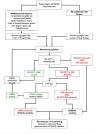Novel electroretinography devices to detect hydroxychloroquine retinopathy: study protocol for a diagnostic accuracy and feasibility study
- PMID: 39719323
- PMCID: PMC11683940
- DOI: 10.1136/bmjophth-2024-001898
Novel electroretinography devices to detect hydroxychloroquine retinopathy: study protocol for a diagnostic accuracy and feasibility study
Abstract
Introduction: Annual screening for hydroxychloroquine (HCQ) retinopathy is recommended, and electroretinography (ERG) is considered a gold-standard test, but there are screening shortfalls and standard ERG is burdensome and has limited availability. Newer, portable ERG devices using skin-based electrodes may increase screening capacity but need validation. This study aims to determine initial device accuracies and feasibility of further research.
Methods and analysis: Prospective diagnostic device accuracy and feasibility study comparing novel ERG devices to standard screening tests. Three groups of 35 participants on HCQ, categorised by HCQ retinopathy (definite, possible and no retinopathy), and 35 healthy control participants, recruited by consecutive sampling, will have full field and multifocal ERG index tests, delivered using skin-contact electrodes by two devices-RETEval full-field and UTAS multifocal ERG, both manufactured by LKC Technologies (Gaithersburg, Maryland, USA), compared with spectral-domain optical coherence tomography and autofluorescence reference tests graded by two masked, independent retinal specialists. Eligible HCQ participants will either have diagnosed HCQ retinopathy or be eligible for screening per UK guidelines. Healthy control participants will have no prior HCQ exposure and be of similar age and sex to HCQ participants. Primary outcome is device-specific sensitivity and specificity. Secondary outcomes include the effect of dilation on device outputs, analysis of discriminatory waveforms, device acceptability and recruitment rate. Safety outcomes include adverse and serious adverse events and device events.
Ethics and dissemination: Cambridge East ethics committee gave a favourable opinion (24/EE/0011, 23/02/2024). Results will be published in a peer-reviewed ophthalmology journal.
Trial registration number: ClinicalTrials.gov NCT06035887.
Keywords: Clinical Trial; Diagnostic tests/Investigation; Electrophysiology; Retina.
© Author(s) (or their employer(s)) 2024. Re-use permitted under CC BY-NC. No commercial re-use. See rights and permissions. Published by BMJ.
Conflict of interest statement
Competing interests: The devices are subject to a cost-free loan agreement between LKC Technologies and the Sponsor. The grants above cover part of CNL’s time on the project, as well as publication costs and conference fees in relation to this project. CNL and GM’s employer receives payments for commercial research trial work in retinal and glaucomatous diseases. TLJ is a consultant/advisor to 2CTech; Alcon; Dutch Ophthalmic Research Centre; iLumen; Opthea; Outlook Therapeutics; Oxurion; Regeneron, and has received conference support from Roche. OM has participated on an advisory board for Janssen 21 Pharmaceuticals. None of the authors hold any stocks, nor receive any royalties or consulting fees from LKC Technologies.
Figures


Similar articles
-
Current screening practice in patients under long-term hydroxychloroquine medication in Taiwan: A nationwide population-based cohort study.Medicine (Baltimore). 2019 Apr;98(14):e15122. doi: 10.1097/MD.0000000000015122. Medicine (Baltimore). 2019. PMID: 30946384 Free PMC article.
-
Revised recommendations on screening for chloroquine and hydroxychloroquine retinopathy.Ophthalmology. 2011 Feb;118(2):415-22. doi: 10.1016/j.ophtha.2010.11.017. Ophthalmology. 2011. PMID: 21292109
-
Frequency and Clinical Characteristics of Hydroxychloroquine Retinopathy in Korean Patients with Rheumatologic Diseases.J Korean Med Sci. 2017 Mar;32(3):522-527. doi: 10.3346/jkms.2017.32.3.522. J Korean Med Sci. 2017. PMID: 28145658 Free PMC article.
-
Hydroxychloroquine retinopathy: A review of imaging.Indian J Ophthalmol. 2015 Jul;63(7):570-4. doi: 10.4103/0301-4738.167120. Indian J Ophthalmol. 2015. PMID: 26458473 Free PMC article. Review.
-
Mimickers of hydroxychloroquine retinal toxicity.Clin Exp Ophthalmol. 2024 Dec;52(9):1003-1015. doi: 10.1111/ceo.14461. Epub 2024 Dec 3. Clin Exp Ophthalmol. 2024. PMID: 39626654 Free PMC article. Review.
References
MeSH terms
Substances
Associated data
LinkOut - more resources
Full Text Sources
Medical
